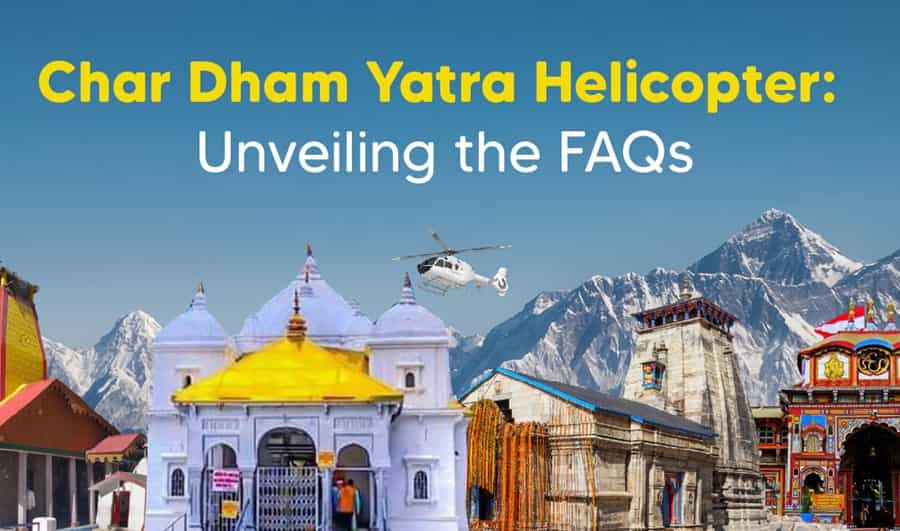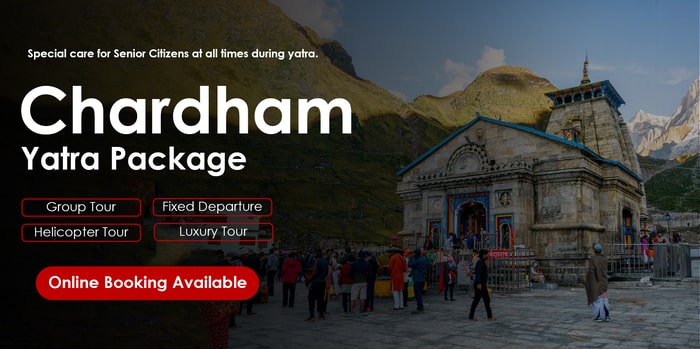The Chardham Yatra is a sacred pilgrimage in India that includes visits to Yamunotri, Gangotri, Kedarnath, and Badrinath. Here are 50 frequently asked questions (FAQs) to help you prepare for this spiritual journey:

General Information
Q-1: What is the Chardham Yatra?
Ans: The Chardham Yatra is a pilgrimage to four sacred shrines in the Himalayas: Yamunotri, Gangotri, Kedarnath, and Badrinath.
Q-2: When does the Chardham Yatra start and end?
The yatra generally begins in late April or early May and ends in October, depending on weather conditions and temple schedules.
Q-3: What is the best time to visit Chardham?
The best time is between May and June, and September to October, avoiding the monsoon season when landslides are common.
Q-4: What are the main shrines in Chardham?
The four main shrines are Yamunotri, Gangotri, Kedarnath, and Badrinath.
Q-5: How long does the entire Yatra take?
The yatra typically takes about 10-12 days, depending on the itinerary and pace of travel.
Travel & Logistics
Q-6: How do I get to Chardham?
The nearest major airports are in Dehradun (Jolly Grant Airport) and Pantnagar. The yatra is usually conducted by road from these points.
Q-7: What is the route for the Chardham Yatra?
A common route is Dehradun/Haridwar → Yamunotri → Gangotri → Kedarnath → Badrinath → Dehradun/Haridwar.
Q-8: What are the transportation options for Chardham Yatra?
You can travel by private vehicles, taxis, or organized tour buses. Helicopter services are also available for Kedarnath.
Q-9: Is there a need for a special permit or pass?
Indian citizens don’t need a special permit, but foreigners need an Inner Line Permit (ILP) for some areas.
Q-10: What are the accommodation options?
Accommodation ranges from budget guesthouses to luxury hotels. It is advisable to book in advance during peak season.
Health & Safety
Q-1: What is the altitude of these shrines?
Yamunotri: 3,293 meters, Gangotri: 3,100 meters, Kedarnath: 3,584 meters, Badrinath: 3,133 meters.
Q-12:How can I prepare for high-altitude travel?
Acclimatize gradually, stay hydrated, avoid strenuous activities, and consult a doctor if you have health issues.
Q-13:What should I do if I experience altitude sickness?
Descend to a lower altitude, stay hydrated, and seek medical attention if symptoms persist.
Q-14:Are there medical facilities available along the route?
Basic medical facilities are available at major stops, but carrying a personal first-aid kit is advisable.
Q-15:What vaccinations are recommended for the trip?
Basic vaccinations such as Hepatitis A, Typhoid, and Tetanus are generally recommended. Consult a healthcare provider for personalized advice.
Clothing & Essentials
Q-16:What type of clothing should I carry?
Carry warm clothing, including thermal wear, as temperatures can drop significantly, even in summer. Waterproof jackets and trekking shoes are also essential.
Q-17:Should I bring any special gear?
Carry a walking stick, rain gear, and personal medications. Good trekking shoes and a warm sleeping bag are recommended.
Q-18:Is it necessary to carry a lot of cash?
While ATMs are available in major towns, it’s wise to carry sufficient cash for smaller purchases and emergencies.
Q-19:Are there any restrictions on what I can carry?
There are restrictions on carrying plastic bags. Use eco-friendly bags and follow local guidelines.
Q-20:What items are prohibited?
Non-vegetarian food, alcohol, and plastic bags are generally prohibited.
Religious & Cultural Aspects
Q-21:What is the significance of each shrine?
Yamunotri is dedicated to Goddess Yamuna, Gangotri to Goddess Ganga, Kedarnath to Lord Shiva, and Badrinath to Lord Vishnu.
Q-22:Do I need to be of a particular religion to participate?
No, the Chardham Yatra is open to people of all religions and backgrounds.
Q-23:Are there any specific rituals to follow?
Devotees typically perform rituals and prayers at each shrine. It’s best to follow local customs and seek guidance from priests.
Q-24:Can I take photographs inside the temples?
Photography is generally not allowed inside the temples. Follow the rules and respect local customs.
Q-25:Is there a dress code for visiting the temples?
Modest dress is recommended. Remove footwear before entering temple premises.
Food & Accommodation
Q-26:What types of food are available along the route?
Basic vegetarian food is available at most places. Carry snacks and bottled water for remote areas.
Q-27:Can I find accommodations at all stops?
Yes, but availability may vary. Book in advance, especially during peak season.
Q-28:Are there any special dietary considerations?
Indian food is predominantly vegetarian along the route. If you have special dietary needs, inform your travel agent or carry your own supplies.
Q-29:Is there clean drinking water available?
Drink bottled or boiled water. Avoid drinking from unknown sources to prevent waterborne illnesses.
Q-30: Can0 food easily?
Yes, vegetarian food is widely available. Many pilgrims prefer vegetarian meals during the yatra.
Booking & Cost
Q-31: How much does the Chardham Yatra cost?
Costs vary based on the mode of travel, accommodation, and services. A basic package can start from INR 20,000 and can go up significantly.
Q-32: Is it better to book a package tour or travel independently?
Package tours can simplify logistics and ensure accommodation, but traveling independently offers more flexibility.
Q-33: Are there any discounts available for group bookings?
Many tour operators offer discounts for group bookings. It’s best to inquire directly with the service providers.
Q-34: What does a typical package include?
Packages often include transportation, accommodation, meals, and sometimes guided tours.
Q-35: Can I get a refund if I need to cancel my trip?
Refund policies vary by operator. Check the terms and conditions before booking.
Emergency & Miscellaneous
Q-36: What should I do in case of a natural disaster or emergency?
Follow local advisories, stay in touch with local authorities, and keep emergency contacts handy.
Q-37: How can I stay connected with family during the trip?
Mobile networks are available in major towns. You may need to rely on satellite phones or internet cafes in remote areas.
Q-38: What are the local customs and etiquette?
Respect local traditions, dress modestly, and be polite to locals and fellow pilgrims.
Q-39: How can I support local communities?
Support local businesses, respect the environment, and contribute to local charitable initiatives if possible.
Q-40: What should I do if I lose my belongings?
Report the loss to local authorities and your travel operator. Keep copies of important documents separately.
Specific to Kedarnath
Q-41: Is a helicopter service available to Kedarnath?
Yes, helicopter services are available from Phata, Sirsi, and other locations.
Q-42: How long is the trek to Kedarnath from Gaurikund?
The trek is approximately 16 kilometers and takes about 6-8 hours depending on your pace.
Q-43: What is the weather like in Kedarnath?
It can be cold and unpredictable. Carry appropriate warm clothing.
Q-44: Are there accommodations in Kedarnath?
Basic accommodations are available, but they can fill up quickly during the peak season.
Specific to Yamunotri
Q-45: How do I reach Yamunotri?
The trek to Yamunotri begins from Janki Chatti, which is reachable by road from various base towns.
Q-46: What is the condition of the trek to Yamunotri?
The trek is approximately 6 kilometers and can be steep. Be prepared for a challenging hike.
Q-47: Are there accommodations in Yamunotri?
Limited accommodations are available, so it’s advisable to book in advance or carry essential camping gear.
Specific to Gangotri
Q-48: How is the road to Gangotri?
The road is well-maintained but can be narrow and winding. Drive carefully and be prepared for traffic jams during peak season.
Q-49: Is there a significant trek involved to reach Gangotri?
No significant trek is required; Gangotri is accessible by road.
Specific to Badrinath
Q-50: How is the road condition to Badrinath?
The road to Badrinath is well-maintained but can be subject to landslides. Travel with caution and check for weather updates.
These FAQ’s guide aims to provide a detailed overview to help you prepare for a smooth and spiritually fulfilling Char Dham Yatra. Safe travels and may your pilgrimage be a rewarding experience!




 Call
Call WhatsApp
WhatsApp Enquiry
Enquiry